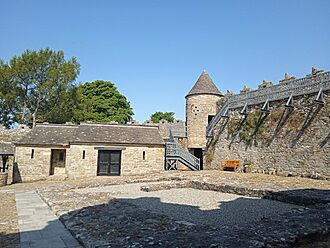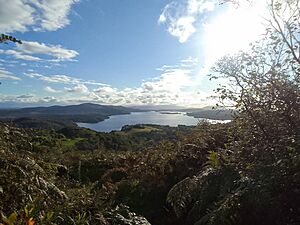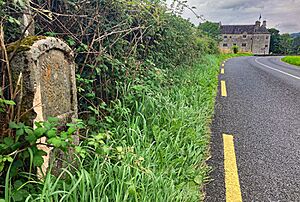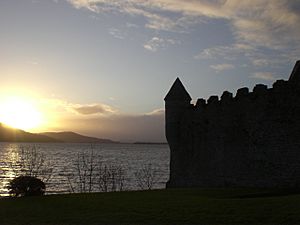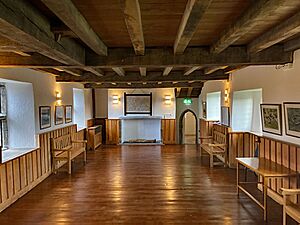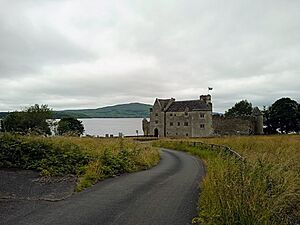Parke's Castle facts for kids
Parke's Castle is a large house built in the 1600s. It was first called Newtowne. You can find it on the shore of Lough Gill in County Leitrim, Ireland.
This castle was built where an older castle, owned by the O'Rourke family, once stood. The English Crown took the O'Rourke castle after its owner, Brian O'Rourke, was found guilty of treason. Captain Robert Parke then leased the land in the 1630s. He was given some of the O'Rourke lands as part of the Plantations, which brought new settlers to Ireland.
Contents
History of Parke's Castle
The O'Rourke Family Castle
The O'Rourke family's castle at Baile Nua (Newtowne) was first mentioned in 1546. This suggests the castle was built around the mid-1400s.
Other places nearby are also linked to the O'Rourke family. Castle Duroy, another old tower house, is close by. In Dromahair village, you can see the ruins of the O'Rourke hall house. Creevelea friary, founded by the O'Rourkes in 1508, is also open to visitors. There's even a mountain called O'Rourke's Table. Local stories say it was a meeting place for the family long ago.
Brian O'Rourke became the leader of his family in 1566. He ruled during a time when England was expanding its power in Ireland. The English were taking more control, especially in the northwest.
Brian O'Rourke often had disagreements with the English. His castle at Leitrim was taken by the English in 1578. But he later made a deal and was even knighted. However, by 1580, Brian was fighting against the English again. He even broke down his own castles, including Newtowne, to stop the English from using them.
Brian O'Rourke's relationship with the English got worse when he helped about eighty Spanish sailors. These sailors were shipwrecked in 1588 during a war between England and Spain. Helping them was seen as an act against England. The English Governor, Richard Bingham, attacked O'Rourke at Newtowne. Brian escaped to Scotland, hoping to gather an army. But he was arrested there and sent to London. This was the first time someone was sent from Scotland to England for trial.
Brian O'Rourke was held in the Tower of London. He was found guilty of treason. On November 3, 1591, he died.
Brian's son, Brian Óg O'Rourke, later became the family leader. He continued his father's fight against the English. He was involved in the Nine Years' War. Not much is known about Newtowne Castle during this time.
Robert Parke's New Castle
The "Plantation of Leitrim" started in 1620. This was a plan to settle English and Scottish people on lands that once belonged to Irish families. Robert Parke was one of these new settlers.
It's not clear exactly when Robert Parke got the land where O'Rourke's castle stood. But by 1628, he had permission to hold a market and fairs at Newtowne. He also had a lot of land. His brother, William Parke, took over another O'Rourke castle in Dromahair.
The old O'Rourke castle was taken down when the English began to build there. Robert Parke built a new castle. First, he built the gatehouse and two strong towers. The main house was built last, probably finished in the mid-1630s. Smaller guard towers and a water gate were added. The courtyard was paved over, covering any signs of the older Irish castle.
Parke did well at Newtowne. He gained more land after a big conflict in Ireland. He also took part in local government. He even hired Irish workers and a Gaelic harp player.
Conflicts and Changes (1641-1652)
Robert Parke became a Justice of the Peace and a Member of Parliament in 1641. He tried to stay out of the 1641 Rebellion, a big conflict in Ireland. Many English settlers tried to avoid the fighting.
However, another settler, Sir Fredrick Hamilton, was angry with Parke. Hamilton thought Parke was helping the Irish rebels. So, in 1642, Hamilton burned the village of Newtowne.
Hamilton also arrested Robert Parke in July 1642. On the same night, Hamilton took Parke and some soldiers to attack Sligo town. Hamilton later said they killed many people and burned the town and Sligo Abbey.
Parke was held prisoner by Hamilton for almost two years. He was finally released when Hamilton was away.
In 1649, Newtowne Castle was held by Parliamentarian soldiers. They later gave it up to Royalist forces. In 1652, the Royalists had to surrender the castle to the Parliamentarians. After these conflicts, Robert Parke returned to his castle and continued his public work.
Later Years of the Castle
Robert Parke married Ann Povey. They had three children: Ann, Robert, and Mary.
Robert Parke died in 1671. His two younger children, Robert and Mary, are not mentioned in his will. This suggests they died before him. There's a local story that they drowned in the lake, but there's no proof. Their oldest daughter, Ann, was the only child who survived. She later married Sir Francis Gore.
The castle then went to the Gore family. But it was soon left empty and became a ruin. It was briefly used by soldiers in 1688 during another war. By 1791, drawings showed the castle in ruins. The main house was empty for nearly 200 years. The courtyard was used as a farmyard by local people until the early 1900s.
The Irish Free State bought the castle in 1935. It has been cared for by the State ever since.
Restoring Parke's Castle
In the early 1970s, archaeologists started digging at the castle. They found the foundations of the old O'Rourke castle under the courtyard's paving stones. They also found parts of other buildings, a well, and a metalworking area. Over a thousand items from the 1500s to the 1800s were discovered. This showed that the site was used for a long time.
After the digs, the castle was rebuilt using old building methods. The Office of Public Works did this work. They added wood panels to the upper floors. The roofs were made with oak wood, using special 1600s carpentry techniques.
New buildings were added for staff, like kitchens and bathrooms. A blacksmith's workshop was rebuilt. The old stables from the 1800s were also rebuilt. Outside the castle walls, parts of the old moat were fenced off. An old Irish "sweathouse" (a type of sauna) was also rebuilt. The castle is now a National Monument.
After all the restoration work, Parke's Castle opened to the public in 1990.
Visiting Parke's Castle
The castle is managed by the Office of Public Works. It is open to visitors from March to November. There is a small fee to enter. You can take a guided tour or explore on your own.
A local bus service, route 563, runs from Sligo to Dromahair and stops at the castle.
See also
 In Spanish: Parke's Castle para niños
In Spanish: Parke's Castle para niños


